iPad mini Review
by Anand Lal Shimpi & Vivek Gowri on November 20, 2012 6:10 PM ESTDesign & Smart Cover
The smaller screen of the mini is joined by the super-slim industrial design from the fifth generation iPod touch that debuted a couple of months ago. I’m actually a pretty big fan of the direction Apple’s mobile design teams have taken recently, the overall visual style is much cleaner and focused now, with less pronounced radiusing and more rectangular profiles across the board. The edges are rounded enough for a very smooth in-hand feel, but the front edge has the same highly polished, chamfered ring around the bezel as the iPhone 5.
The dark monochromatic look is very sleek; combined with a brightly colored Smart Cover like the red one, the effect is pretty striking. The white/silver colour scheme, as on the iPhone 5, is elegant, but nowhere near as visually striking as the uniformly dark mini.
The face should be very familiar to iDevice users - a front facing camera centered at the top, an ambient light sensor to the left of it, and a home button at the bottom. The home button has been shrunk, though it’s set far enough away from the screen that I feel like they could have easily kept the same home button that is used in the other iDevices. I’m assuming there’s a reason for the downsizing, probably relating to the placement of the hardware around the display, because this isn’t the type of thing typically overlooked by Jony Ive and Co.
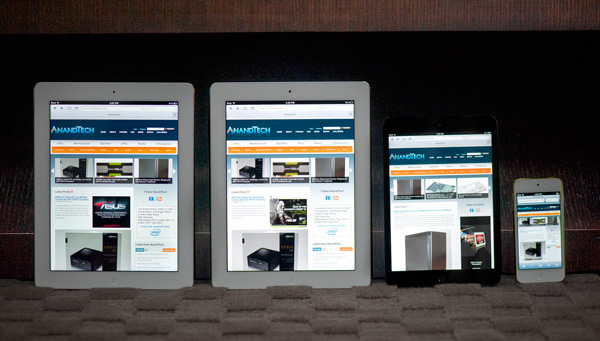
From left to right: iPad 4, iPad 2, iPad mini, iPod Touch (5th gen)
The bezel has been reduced considerably in size in all four directions, but more so on the sides than to the top and bottom. The result is a device with a slightly different physical aspect ratio than the 9.7” iPad - 4.45:3 instead of 3.90:3 (where, in both cases, the display has an aspect ratio of 4:3). The narrower bezel looks good - cleaner and more modern, and I think the iPad mini is better proportioned aesthetically. Of course, the smaller footprint is also one of the main factors in the awesome in-hand feel, so it’s a functional decision as much as an aesthetic one. Surprisingly enough, the lack of bezel on the sides of the mini doesn't impact normal use. Apple tweaked iOS a bit to improve touch rejection along the edges of the mini.
Button and port placement is identical to the preceding iPads, with a few minor but important changes. The silence/rotation lock slider in particular feels much more robust than in previous editions. The top edge has the power button on the right and headphone jack on the left, with volume buttons on the right edge, next to the camera. The buttons themselves are now metal, and offer better feel and feedback than the plastic buttons of the 9.7” iPad.
Coming around the edge to the bottom, we see that the 30-pin dock connector has been replaced by the new Lightning port, centered as always. The mono speaker in the right corner of the back is now gone, superceded by a pair of speakers set on either side of the Lightning port. That’s right - the iPad finally has stereo speakers, and they’re actually pretty decent. Clean sound output, and loud enough to fill a 400 sq ft room without distorting at high volumes. As with most mobile devices, the sound is a bit thin, but a decent improvement over my admittedly low expectations.
Given that the iPad mini shares the same colors and materials as the iPhone 5, I was curious to see whether the paint would be as fragile and whether we’d see a repeat of the quality control issues Apple had with it at launch. Thankfully, the anodization seems far more robust and significantly more resistant to scratching, even on the polished aluminum band at the front. I didn’t see any material or paint defects when I unboxed it, even after a thorough going over, and through two weeks of not particularly gentle use, I haven’t seen any scratching. It’s a very different experience than my iPhone 5, which came out of the box with the front panel not properly clipped into the aluminum frame and scratched whenever I looked at it wrong. This isn’t a device that needs any other kind of case unless you plan on abusing it, and I feel like a larger case would undo some of the benefit of the ultralight chassis.
Apple does built a custom Smart Cover for the mini, available in a number of colors. Unlike the bigger Smart Cover, the mini's cover integrates the magnetic hinge into the same material as the rest of the cover, resulting in a very cohesive design:
The big benefit of the Smart Cover is the ability to use it as a stand:
The angle of the folded Smart Cover is considerably larger than on the standard iPad, making the iPad mini lean back more vs. standing upright on the bigger model:
I would recommend getting a Smart Cover for the versatility of the stand and to have some form of protection for the screen. Plus, the black iPad mini + red Smart Cover combination just looks awesome.


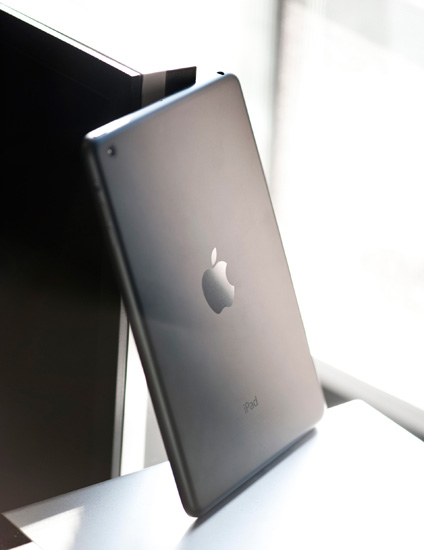
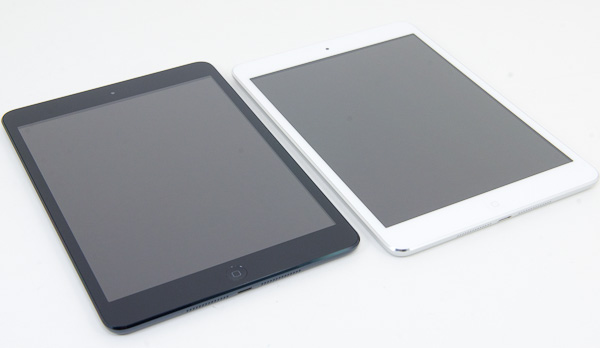
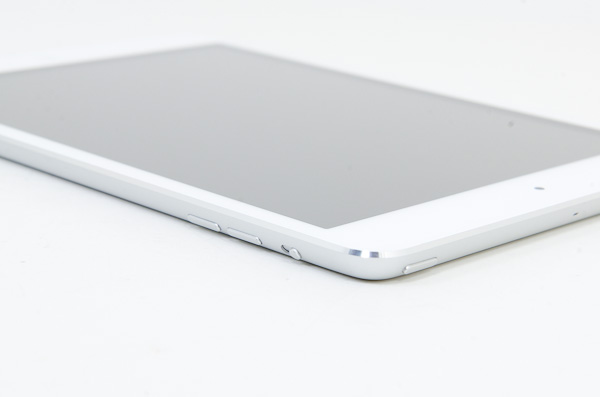
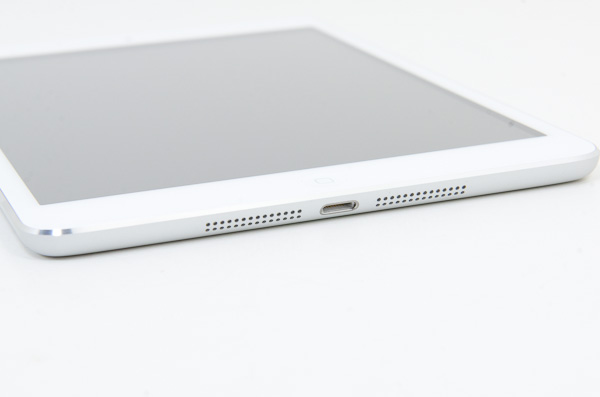
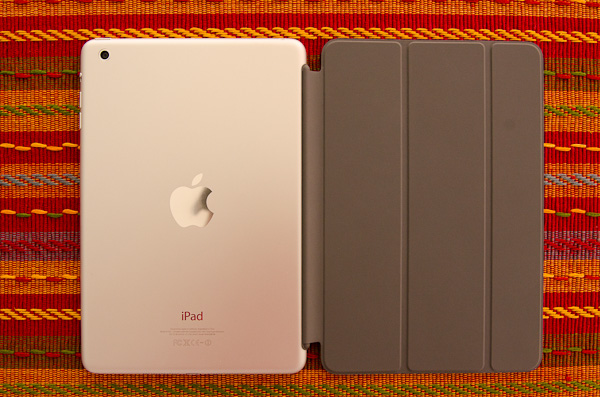
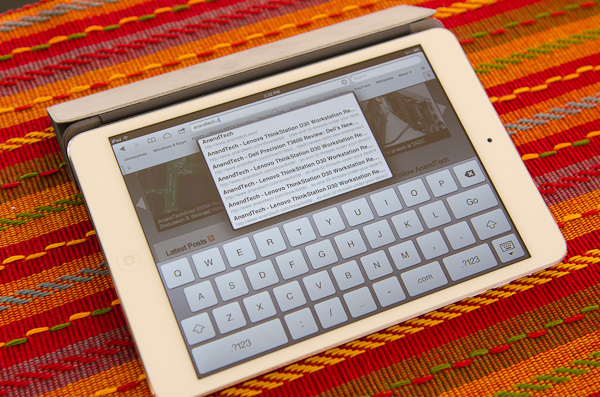
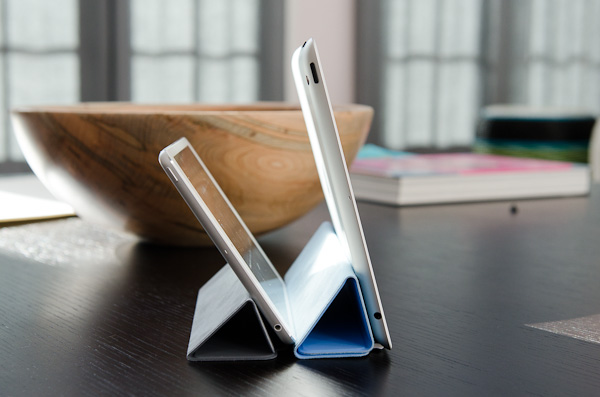








140 Comments
View All Comments
protomech - Tuesday, November 20, 2012 - link
Top of the summary gives it away:"In my first week with the iPad mini, it quickly became the iPad I actually wanted to carry around. The mini's form factor is really where all of the innovation is. It's thin, light and an almost perfect balance of functional screen size and portability. I really love this form factor."
By specs, the mini is unimpressive. It's using a SOC introduced in early 2011. We've been accustomed to high resolution mini-tablets from B&N, Amazon, Google, etc. It has less memory and costs significantly more (particularly for higher SKUs).
But, at least for the reviewer, the form factor trumps all these things, at least for purposes of a "carry computer". Thinner and lighter than the 7" tablet comparison, with significantly more usable display space (Android 4.x soft buttons do not help here) in nearly the same frontal area.
Would it be a better product if it sported an A6X SOC and a retina display? Certainly, on paper. It also likely would need a ~25 Wh battery and substantial increases in both weight and thickness .. same sort of changes from the iPad 2 to iPad 3.
iPad mini should have been introduced last year when the 32nm SOC was available IMO .. it would have provided a useful bifurcation vs the 3rd gen iPad's bulk gains, and perhaps we'd have an A6 SOC in the iPad mini today.
seanleeforever - Tuesday, November 20, 2012 - link
not sure how that quote answers Jorange's questions. but that's the internet nowadays.protomech - Tuesday, November 20, 2012 - link
Is it? It looks like it's a reply to Greg512. Certainly that's how I intended it.But, as you say, that's the internet nowadays.
ltcommanderdata - Tuesday, November 20, 2012 - link
I doubt Apple could have shipped a 32nm SoC last year in volume. The A5r2 was already the first shipping SoC produced on Samsung's 32nm process, ahead of Samsung's own designs, when it launched on the iPad2,4 in March 2012. And that was only used for low volume test production with the 45nm A5 iPad 2 continuing to be available. Apple prioritizing the iPhone 5 to receive a 32nm SoC first and waiting until now for high volume 32nm production to introduce 32nm iPad Mini, 5th gen iPod Touch, and iPad 4 makes sense.protomech - Tuesday, November 20, 2012 - link
Good point.. I thought it had shipped late last year.KoolAidMan1 - Wednesday, November 21, 2012 - link
"By specs, the mini is unimpressive."GPU performance is still surprisingly good, better than even the newest Android-running hardware. What is it with other companies not keeping up with Apple's older hardware?
Greg512 - Wednesday, November 21, 2012 - link
Yea, the GPU is good. But, for the price, the screen, CPU, and RAM are kinda poor. The Mini performs well now, but I question its long-term viability.marvdmartian - Wednesday, November 21, 2012 - link
Typical Apple product, that will sell like hotcakes: getting less, paying more, nothing new.drx11 - Sunday, November 25, 2012 - link
---------------------------------------------------------RE: Not a bad product by marvdmartian on Wednesday, November 21, 2012
Typical Apple product, that will sell like hotcakes: getting less, paying more, nothing new.
---------------------------------------------------------
Typical Fandroid, never sees the forest for the trees.
Apple is the best and has been so since 2007 - at building SoC.
Apple is the best at supporting its devices long term.
Now with iOS 6 - which is mostly supported (not all the features) for an old 3GS phone - you could argue you are getting less - maybe on the older devices (no Siri, Apple Maps is not as good as as Google Maps ... right now... etc..)
Still iOS 5 is very nice for older things and Android/Google/Moto/Samsung/HTC has rarely updated their "better" hardware at all ... you can blame that on the carriers all you want, but that is also what you are buying.
Buying more often, spending more time doing something that maybe should just work?
I know Google is trying (or starting to), but they really have almost no support for the majority (75%+ ) of the devices in their 'ecosystem'. What's the point of better hardware when it runs slower/worse from the start and never gets updated?
Alucard291 - Monday, November 26, 2012 - link
Did you have a joint before you wrote this drivel? Or does your mind work this bad drug free? ^^Good SoCs? Are you serious? Just because people work'd the shaft so hard when A6 came out doesn't mean that Cortex A9 based soc is viable coming into 2013.
Apple is currently behind the curve on both tech processes (28 nm vs 32 nm) and performance (cpu and ram speed but not gpu)
In case of ipad mini. You get less. (2 year old tech) you pay more (than any competition out there). But somehow we miss the forest for the trees?
Oh but it supports the amazing dated and feature free ios6! That's great. Except well.. (opinion incoming) I don't like ios. I find it restrictive and boring.
So your point is?